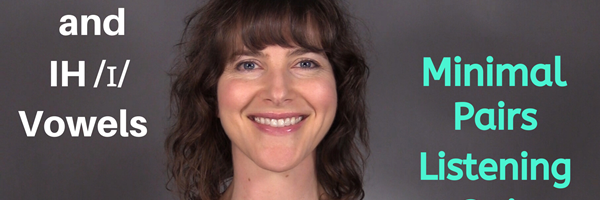The EE /i/ in beat and the IH /ɪ/ in bit are two of the vowels that I target with almost all of my clients. The EE vowel is relatively common in most languages, so you may not have difficulty pronouncing EE correctly. The more difficult vowel is the IH vowel, which is a common vowel in English, but it might not occur in your native language.
The key differences between EE and IH are the lip positioning and the tension. Watch my lips as I say EE: EEE. You should see that my lips spread out. There is also tension within the muscles of my tongue, face, and upper neck. I can feel this tension when I put my hand under my chin: EEE, EEE, EEE.
Now look at the IH vowel. IH, IH. First you should notice that my lips are in a more neutral, partially-spread position. IH, IH. Second, there is much less tension in the muscles in my face, tongue, and upper neck. IH, IH.
Here are sounds side by side: EEE, IH. EEE, IH.
Let’s practice these sounds with a visual test. I’ll say two words that either contain the EE vowel or the IH vowel. I’ll mute the microphone so you can’t hear what I’m saying - you’ll only be able to see my face as I talk. Try to guess which word I’m saying based on my lip positioning. Spread lips is the EE sound; neutral lips is the IH sound.
TEST:
1) seat or sit?
Answer: 1st word: sit; 2nd word: seat.
2) meat or mitt?
Answer: 1st word: meat; 2nd word: mitt
3) leap or lip?
Answer: 1st word: leap; 2nd word: lip
4) peach or pitch?
Answer: 1st word: pitch; 2nd word: peach
5) week or wick?
Answer: 1st word: wick; 2nd word: week
Great job! Now let’s do the same test but with phrases and sentences. I’ll use the same words as before, and I’ll mute the microphone like I did before, so all you’ll see is my face. Watch my lip positioning and guess which sentence I’m saying. And some of these sentences don’t make sense - that’s OK for this type of practice!
TEST:
1) “This is my seat” or “This is my sit”?
Answer: 1st sentence: “This is my seat”; 2nd sentence: “This is my sit”
2) “The meat is good” or “The mitt is good”?
Answer: 1st sentence: “The mitt is good”; 2nd sentence: “The meat is good”
3) “It’s a leap of faith” or “It’s a lip of faith”?
Answer: 1st sentence: “It’s a lip of faith”; 2nd sentence: “It’s a leap of faith”
4) “Take the peach” or “Take the pitch”?
Answer: 1st sentence: “Take the pitch”; 2nd sentence: “Take the peach”
5) “It’s been a long week” or “It’s been a long wick”?
Answer: 1st sentence: “It’s been a long week”; 2nd sentence: “It’s been a long wick”
Thanks so much for watching! And I'd love to hear from you - contact me to learn how we can work together to perfect your American English pronunciation!



